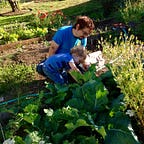Plant Weird Seeds
Suggestions for Gardening in a Changing Climate
Permaculture is great, but in a changing climate a garden and the humans who participate in it need to be reactive as well as proactive. The Wheel of the Year has come off its axle, and it’s up to each grower to figure out the best way to participate in her climate. Here are some possible approaches.
- Be Okay with Losses.
Your garden is now officially an experiment. In order to figure out what works best, you’re going to have to deal with losses. If something doesn’t work — seeds don’t germinate, plants wilt in the heat or bolt or refuse to flower — be okay with that.
2. Do As Little As Possible.
Research no dig/no till methods for your soil. Fertilize sparingly. Water as often as you have time for, and if something you really want to survive needs it, but no more. Avoid installing crazy, expensive irrigation systems and use water generated on-site.
Let some plants go to seed, but don’t pull them — see if they easily self-seed from year to year so you don’t have to “worry about it.”
When you figure out what works best with the least amount of effort on your part, do that. You’ll save time, energy, and money.
3. Grow from Starts.
Starting from seeds is a pain in the ass a lot of times. You never really know how they’re going to do, and it’s going to be harder to figure out what will grow as the weather gets weirder. Starting seeds indoors takes space and equipment. Instead of wasting effort on trying to grow your favorites from seed, just buy or trade for starts. Support your local nursery. Know how to save seeds, just in case, but make it easy if you already know it’ll work.
4. Plant Weird Seeds.
Plant unusual species in unusual places. Figure out what will work really well with the least amount of effort, and grow that every season. Try new plants and cultivars each year and explore different sources of food. Sow seeds randomly, in different areas, to discover which plants will grow in which conditions in your garden.
Don’t rely on natives! Over the next decades, who knows whether a species that’s survived in your climate for thousands of years will continue to do so? Try species from different, warmer USDA Zones. Are you in Zone 8? Try planting something that grows in Zone 9 or 10:
Also, get to know Analogue Climates:
http://www.ccafs-analogues.org/tool/
This tool will allow you to input your location and find out what other places have similar climates. Plants growing there should grow where you are, and vice-versa.
5. Only Plant Useful Ornamentals.
Oxalis is beautiful year round here in the Pacific Northwest. It’s also completely edible, and tastes lemony.
Research every single plant you plan to add to your garden — not just for purposes of care and cultivation, but also how they can be used. MOST ornamentals have uses.
6. Invite Them In and Let Them Grow.
My garden has been colonized by Yellow Dock, and I couldn’t be happier.
The leaves are delicious, the roots are medicinal, and I didn’t have to plant them. It’s a “weed,” but in among the baby garlic it won’t hurt anything.
I also have a large crop of “feral” turnips growing at the moment. I didn’t plant them (maybe they came from a bird, or in a cover crop mix?), but they had interesting leaves so I opted not to pull them either. Now we’ve been eating delicious turnip greens and roots all winter.
Instead of tearing out all of your “weeds,” let a few grow to figure out what they are, and incorporate them. You will probably be well rewarded!
7. Use Magic.
Make totems:
Crucifer up there has been watching our collards and kale all winter, and we’ve been eating them the whole time.
We’ve also had a metric ton of bittercress — a wild Brassica — start to emerge early this year. Is it because of the totem?
We sprinkled ashes from our Yule Log on the garden, once each day on each of the Twelve Days of Christmas. Will it increase our soil fertility?
